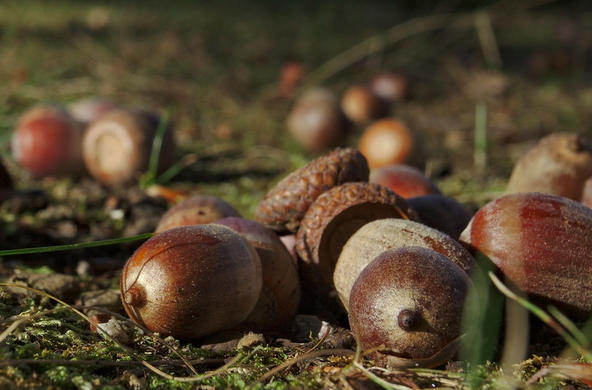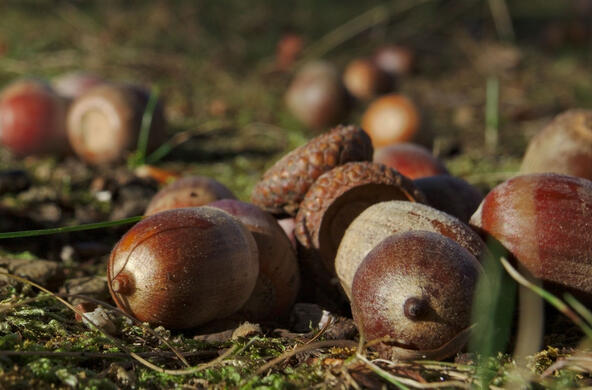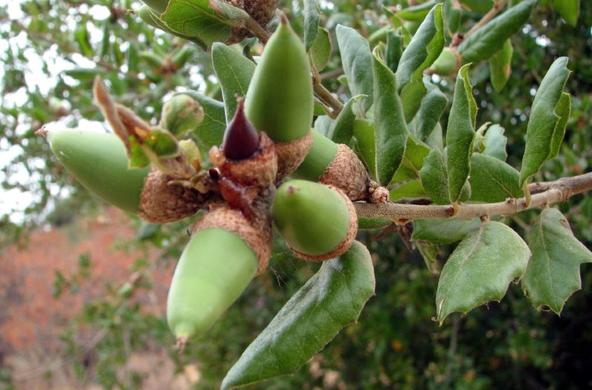Hub Species
Some of the clearest examples of the consequences of pulsed resources are found in deciduous and coniferous forests dominated by mast-producing trees such as oaks. In these systems, populations of mast-consuming mammals, such as the white-footed mouse (Peromyscus leucopus), and eastern chipmunk (Tamias striatus) initiate cascades of direct and indirect effects that permeate throughout these forest-based food webs. White-footed mice in particular, and their counterparts in other terrestrial communities, are considered a "hub species" because they are central to a web of interactions with various predators, prey, competitors, parasites, and pathogens.
Our studies have revealed that episodic acorn production directly influences: (1) the abundance, distribution, and behavior of white-footed mice. As a consequence, acorn production indirectly influences: (2) tick abundance, infection prevalence and Lyme disease risk; (3) population dynamics of gypsy moths; (4) nesting success and population dynamics of ground-nesting songbirds; and (5) survival of tree seeds and seedlings.
Mast-Consuming Animals
"Mast production" or "masting" refers to the synchronous, episodic production of heavy seed crops by a population of plants. Heavy acorn production, which generally occurs once every 2-5 years in deciduous forests, is an example of masting. The evolutionary and physiological causes of masting have been intensively studied by ecologists, but the ecological consequences of this episodic pattern of resource superabundance are less well understood. Acorns are a highly nutritious food source for many species of mammals and birds, including white-footed mice. Mice store acorns for winter consumption, when food sources are generally scarce.
We have used both long-term monitoring and experimental enhancement of acorn abundance to determine the effects of acorns on mouse populations. Long-term monitoring demonstrates that summertime abundance of mice is strongly correlated with acorn production during the prior fall. Experimental acorn additions indicate more mice survive the winter when acorns are abundant and winter reproduction only occurs when acorns are present. Following acorn mast years, as a result of higher over-winter survival and winter breeding, population growth starts earlier in the season, leading to higher peak densities of mice in summer.
Pulsed Resources
Many terrestrial ecosystems are characterized by intermittent production of abundant consumer resources, such as mast seeding and pulses of primary production following unusually heavy rains during El Niño events. Generalities are emerging about how consumer communities respond to these periods of feast and famine. Pulsed resource theory now integrates concurrent theories of top-down and bottom-up control, direct and indirect effects on population dynamics, and temporal variation in interaction webs. A general pattern of resource pulses resulting in consumer growth and decline at several trophic levels has been has been observed in North America, Eurasia, South America, and New Zealand (Ostfeld and Keesing 2000)
Gypsy Moth Predation & Mice
During outbreak years, gypsy moths, an exotic pest of oak forests in eastern North America, can defoliate thousands of hectares of forest and kill millions of trees. White-footed mice are by far the most effective predators on the pupal (cocoon) stage in the life cycle of the gypsy moth.
Our experimental and observational studies strongly support the hypothesis that mice regulate low-density populations of gypsy moths by voraciously attacking pupae. In fact, given the intensity of mouse predation on moth pupae, our research now focuses on how gypsy moths escape extinction.
Preliminary results suggest that extinction is avoided only when the probability of surviving mouse predation is highly variable in space, and when gypsy moth larvae disperse only short distances away from sites in which their mothers survived. A crash in the mouse population - typically caused by an acorn failure - appears to be important in allowing moth populations to grow.
In addition to mouse population density, mouse foraging behavior plays an important role in gypsy moth dynamics and is currently being researched. Although individual mice tend to become less efficient in attacking moth pupae when pupal density is low, their attack rates still seem sufficient to further reduce moth populations, and their ability to forage more efficiently, via learning, seems strong.
Songbird Populations & Mice
Because they regulate small mammal populations, mast seed crops have the potential to exert strong indirect effects on songbird populations. When more small mammals are present, nest predation rates increase, resulting in decreases in both nest productivity and the recruitment of breeding adults. White-footed mice and eastern chipmunks attack eggs within nests of ground-nesting and shrub-nesting birds. Our long-term monitoring data indicate that fledging success of veeries, red-eyed vireos, and woodthrushes is poor in years of high mouse abundance and good in years of low mouse abundance. Our expectation, therefore, was that population density of vulnerable songbirds would be inversely correlated with prior year's mouse density and with acorn production two years previously. In fact, we found that veery and woodthrush abundance was strongly reduced following a summer of abundant mice, but that these birds also were scarce following a summer of low mouse abundance. Only following intermediate mouse years did these birds thrive.
We are currently testing the hypothesis that low bird abundance following rodent population crashes was caused by aerial predators increasing their attack rates on fledgling and/or adult birds in the year of a rodent crash. Christmas Bird Count data for Sharp-shinned and Cooper's hawks demonstrate a positive correlation between rodent abundance and accipiter abundance the next year, supporting this hypothesis. Songbird predation by accipiters when rodents are scarce, in combination with high nest predation by mice and chipmunks when these rodents are abundant, may explain the unimodal relationship. Nonlinear relationships between predator and prey abundance and indirect interactions appear to characterize this system.
Seed Survivorship & Seedling Establishment
Not only do tree seeds have an important bottom-up effect on mice, but also mice have strong top-down effects on seed survival and seedling establishment. Previous studies conducted in old fields adjacent to deciduous forest showed that the survival of experimentally introduced seeds was strongly negatively correlated with mouse abundance.
More recently, we (Schnurr et al. 2004) have assessed whether temporal and spatial variation in mouse abundance affects seed survival and subsequent seedling establishment. We found that the distribution and activity of a guild of small mammals was predictable on the basis of the distribution of canopy trees in neighborhoods (ca 100-200 m2 areas) that represent both individual adult tree canopies and small-mammal home ranges. Granivorous small mammals distribution, in turn, was a good predictor of the intensity of predation on experimentally introduced seeds.
Neighborhoods in which seed predation was lowest were characterized by the highest natural rates of seedling recruitment. If the seedling recruitment signal persists into the sapling and adult tree stages, then canopy trees would appear to be influencing their own neighborhood-specific population dynamics indirectly via their impacts on seed predators.





